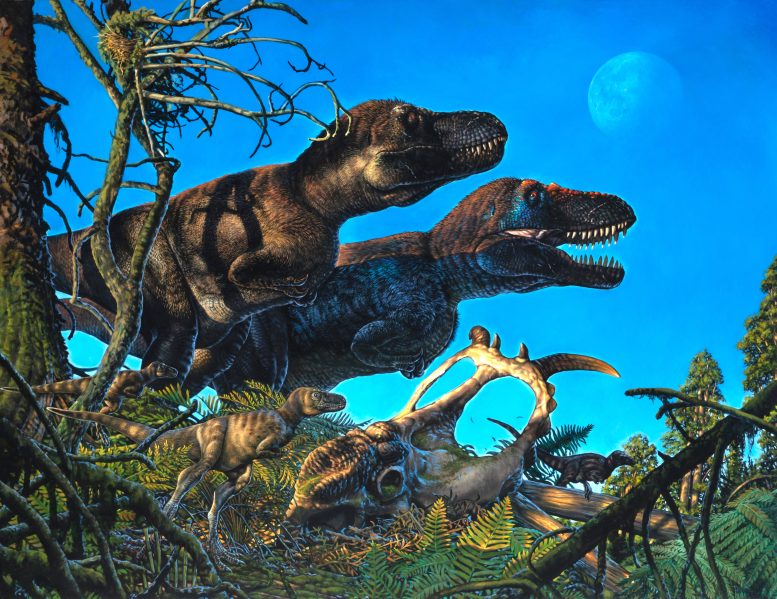
A new study led by scientists from the University of Alaska Fairbanks and the University of Reading includes Nanuxaurus in the background and Pachyrhinosaurus in the foreground, questioning Bergman's rule. Credit: James Havens
When you throw dinosaurs into the mix, sometimes a rule simply doesn't exist.
A new study led by scientists at the University of Alaska Fairbanks and the University of Reading calls into question Bergman's Law, a scientific principle from the 1800s that states that animals in high-latitude, cold climates tend to be larger than their closest relatives living in warmer climates. .
The fossil record suggests otherwise.
„Our study shows that the evolution of different body sizes in dinosaurs and mammals cannot be reduced simply to a function of latitude or temperature,” said Lauren Wilson, a UAF graduate student and lead author of the paper published in the journal. Natural communication. „We found that Bergmann's law only applies to a subset of homeothermic animals (those that maintain a constant body temperature), and only when you consider temperature while ignoring all other climatic variables. This suggests that Bergmann's 'rule' is actually the exception rather than the rule.”
A study of Bergman's rule in dinosaurs and modern organisms
The study began as a simple question that Wilson discussed with his undergraduate advisor: Does Bergman's law apply to dinosaurs?
After evaluating hundreds of data points collected from the fossil record, the answer seemed to be a solid „no.”
The dataset includes the northernmost dinosaurs known to scientists, from Alaska's Prince Creek Formation. They experienced frost and snow. However, the researchers found that none of the Arctic dinosaurs had a significant increase in body size.
Next, the researchers tried the same assessment with modern mammals and birds, the descendants of prehistoric mammals and dinosaurs. The results were largely the same: latitude did not predict body size in modern birds and mammals species. There was a slight relationship between body size and temperature in modern birds, but not in prehistoric birds.
The researchers say the study is a good example of how scientists can and should use the fossil record to test current scientific rules and hypotheses.
„The fossil record provides a window into vastly different ecosystems and climatic conditions, allowing us to assess the applicability of these ecological rules in a completely new way,” said Jacob Gardner, a postdoctoral researcher at the University of Reading and the other lead author. Paper.
The same rules of science apply to fossil organisms as they do to modern organisms, said Pat Druckenmiller, director of the University of Alaska Museum of the North and one of the paper's co-authors.
„You can't understand modern ecosystems if you ignore their evolutionary roots,” he said. „You have to look at the past to understand how things are today.”
Note: Lauren N. Wilson, Jacob D. Gardner, John B. Wilson, Alex Farnsworth, Zachary R. Perry, Patrick S. Truckenmiller, Gregory M. Erickson and Chris L. The Organ, 5 April 2024, Natural communication.
DOI: 10.1038/s41467-024-46843-2

„Oddany rozwiązywacz problemów. Przyjazny hipsterom praktykant bekonu. Miłośnik kawy. Nieuleczalny introwertyk. Student.
